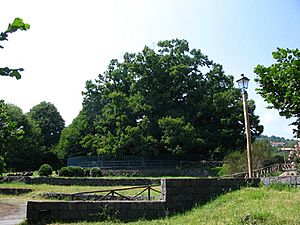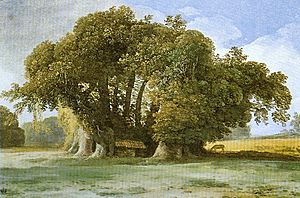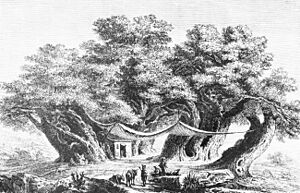Hundred Horse Chestnut facts for kids
The Hundred-Horse Chestnut (called Castagno dei Cento Cavalli in Italian) is the biggest and oldest known chestnut tree on Earth! You can find it on the eastern side of Mount Etna in Sicily, Italy. It's only about 8 kilometers (5 miles) from the volcano's top.
Experts believe this incredible tree is between 2,000 and 4,000 years old. Some even say it's the oldest tree in Europe! It's a type of tree called a sweet chestnut.
The Guinness World Records book lists it for having the "Greatest Tree Girth Ever." In 1780, people measured its trunk, and it was an amazing 57.9 meters (190 feet) around! Even though the tree has split into many large trunks above the ground, they all share the same roots underground.
The tree got its special name from a famous legend. The story says that a queen from Aragon and her 100 knights were visiting Mount Etna when a huge thunderstorm hit. They all found shelter safely under the giant tree!
About the Tree
This famous tree grows in a forest called Carpineto. It's located on the eastern slopes of the Etna volcano, inside the Etna park area.
Many plant experts agree that the tree is very old. They think it's between two and four thousand years old. A botanist named Bruno Peyronel from Turin believes it might be the oldest tree in Europe. He also thinks it's the largest tree in Italy.
A Look Back in Time
People have known about the Hundred-Horse Chestnut for a very long time. The first written records about it go back to the 1500s.
In 1611, a writer named Antonio Filoteo mentioned the tree. Later, in 1636, Pietro Carrera wrote about its huge trunk. He said it was so big that "thirty horses" could fit inside it!
In 1745, the government in Sicily took an important step. They created a special document to protect the Hundred-Horse Chestnut and another nearby chestnut tree. This was one of the very first times that a natural landmark was officially protected in Sicily. It shows how special this tree was, even hundreds of years ago!
The Tree in Stories
The Hundred-Horse Chestnut and its legend have inspired many writers and poets. They have written songs and poems about this amazing tree.
One poet from Catania, Giuseppe Borrello, wrote about the tree in the Sicilian language. He described how its branches formed a huge umbrella. This umbrella protected the queen and her hundred knights from a fierce storm. That's how the tree got its name, "the great chestnut tree of one hundred horses."
Another poet, Giuseppe Villaroel, wrote about the tree in Italian. He described its huge trunk like an "enormous millenary tower." He also wrote about its green branches swaying in the wind. He saw the tree as a powerful, ancient being, strongly connected to the earth.
The 2018 book The Overstory by Richard Powers also mentions the tree. It says that "a chestnut in Sicily two hundred feet around sheltered a Spanish queen and her hundred mounted knights from a raging storm." This shows how the tree's story continues to inspire people around the world.
Images for kids
See also
 In Spanish: Castaño de los cien caballos para niños
In Spanish: Castaño de los cien caballos para niños







